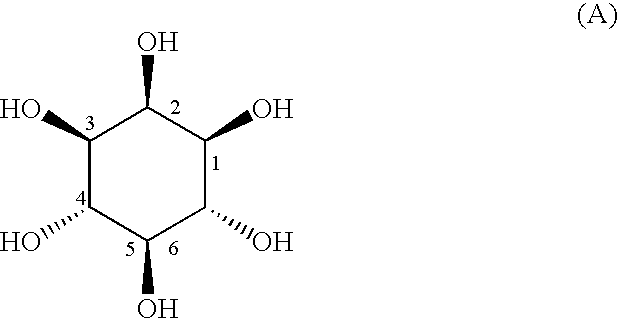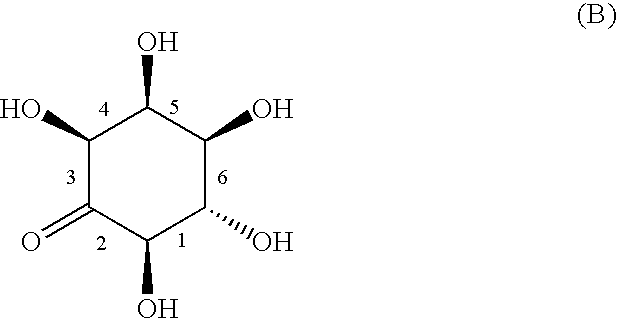Process for producing L-epi-2-inosose and novel process for producing epi-inositol using microorganisms
a technology of epiinositol and process, applied in the field of process for producing lepi2inosose and novel process for producing epiinositol using microorganisms, to achieve the effect of reducing efficiently to epiinositol
- Summary
- Abstract
- Description
- Claims
- Application Information
AI Technical Summary
Benefits of technology
Problems solved by technology
Method used
Image
Examples
example 2
Second Example of Production of L-epi-2-inosose by Procedure (A) According to the First Aspect Process of this Invention
(1) Preparation of Seed Culture
[0098]Into each of baffled Erlenmeyer flasks of 500 ml-capacity was poured a 100 ml-portion of a liquid culture medium which comprised 2.0% of myo-inositol, 0.2% of yeast extract, 0.1% of (NH4)2 SO4, 0.7% of K2 HPO4, 0.2% of KH2 PO4 and 0.01% of MgSO4 7H2O and had the pH of 7. Then, the flasks were sterilized in an autoclave. The sterilized culture medium in each flask was inoculated with Xanthomonas sp. AB 10119 strain (FERM BP-7168), and the inoculated bacterial strain was cultivated under shaking at 27° C. for 1 day. The resulting culture broth was used as the seed culture for the following step of the process.
(2) Production of L-epi-2-inosose in 4 liter-volume-jar fermentors
[0099]Into each of 4 liter-capacity-jar fermentors was poured a 2.5 liter-portion of a liquid culture medium which comprised 12.0% of myo-inositol, 1.2% of yea...
example 3
Example of Production of L-epi-2-inosose by Procedure (B) of the First Aspect Process of this Invention
[0104](1) Production of microbial cells Into each of 500 ml-capacity-baffled Erlenmeyer flasks was poured a 100 ml-portion of a liquid culture medium (totally 2 liters) which comprised 0.5% of myo-inositol, 0.1% of (NH4)2SO4, 0.7% of K2HPO4, 0.2% of KH2PO4 and 0.01% of MgSO4 7H2O and had the pH of 7. Then, the flasks were sterilized in an autoclave. The sterilized culture medium in each flask was inoculated with Xanthomonas sp. AB 10119 strain (FERM BP-7168), and the inoculated bacterial strain was cultivated under shaking at 27° C. for 3 days. The resulting culture broth was centrifuged to separate the microbial cells. The resulting microbial cells so separated were rinsed with 200 ml of 0.05 M phosphorate buffer solution (pH: 7.0) and then centrifuged again to give the rinsed microbial cells of the bacterium.
(2) Production of L-epi-2-inosose
[0105]The rinsed microbial cells as obt...
example 4
Example of Production of Epi-inositol by Procedure (C) of the Second Aspect Process of this Invention
(1) Production of L-epi-2-inosose
[0108]Into each of 500 ml-capacity-baffled Erlenmeyer flasks was poured a 100 ml-portion of a liquid culture medium (totally 2 liters) which comprised 25.0% (500 g) of myo-inositol, 1.0% of glucose and 2.5% of yeast extract, with the pH being not adjusted. Then, the flasks were sterilized in an autoclave. The sterilized culture medium in each flask was inoculated with Xanthomonas sp. AB 10119 strain (FERM BP-7168), and the inoculated bacterial strain was cultivated under shaking at 27° C. for 5 days. The resulting culture broth was centrifuged (8000 rpm., for 20 minutes) to afford the culture broth supernatant liquid.
[0109]This culture broth supernatant liquid was analyzed by a high performance liquid chromatography similarly to Example 1 (1). As a result, it was confirmed that 415 g of L-epi-2-inosose was produced in said culture broth supernatant li...
PUM
| Property | Measurement | Unit |
|---|---|---|
| temperature | aaaaa | aaaaa |
| temperature | aaaaa | aaaaa |
| reaction temperature | aaaaa | aaaaa |
Abstract
Description
Claims
Application Information
 Login to View More
Login to View More - R&D
- Intellectual Property
- Life Sciences
- Materials
- Tech Scout
- Unparalleled Data Quality
- Higher Quality Content
- 60% Fewer Hallucinations
Browse by: Latest US Patents, China's latest patents, Technical Efficacy Thesaurus, Application Domain, Technology Topic, Popular Technical Reports.
© 2025 PatSnap. All rights reserved.Legal|Privacy policy|Modern Slavery Act Transparency Statement|Sitemap|About US| Contact US: help@patsnap.com



